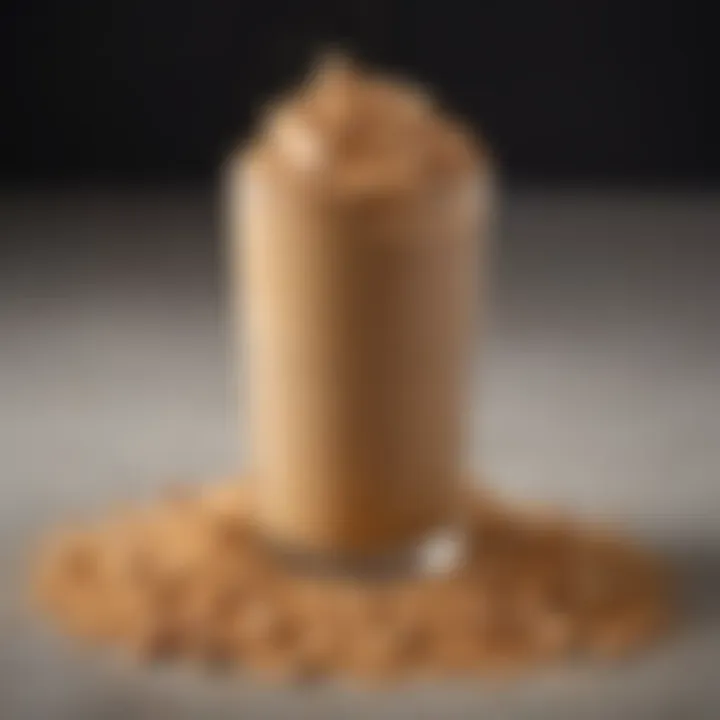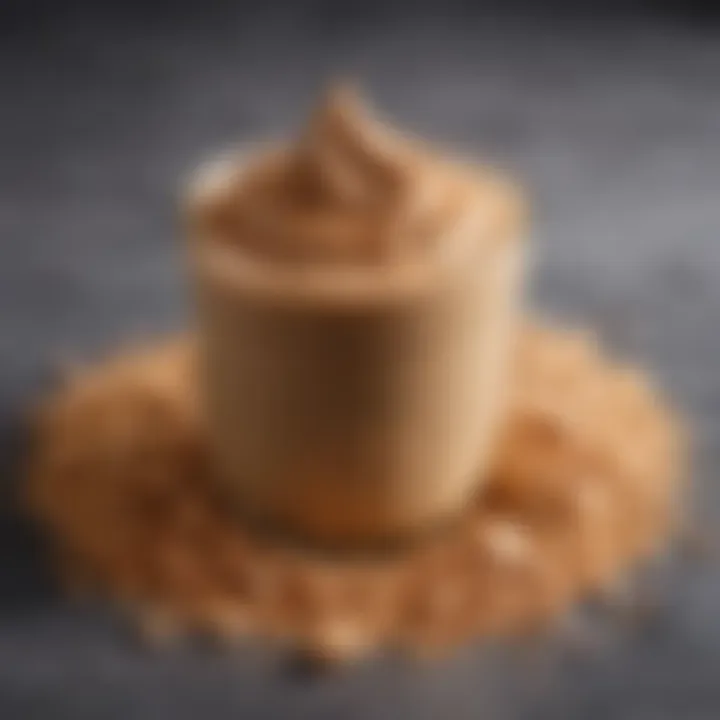Exploring Peanut Butter Powder Smoothies: Benefits & Recipes


Intro
Peanut butter powder has gained significant attention in the culinary world, especially for its incorporation into smoothies. As more people embrace health-conscious diets, this ingredient stands out due to its unique blend of flavor and nutrition. This article aims to explore peanut butter powder smoothies in detail, discussing their benefits, preparation methods, and various recipe ideas. For food lovers, understanding how to integrate this ingredient can lead to flavorful and nutritious drinks.
Recipe Overview
Recipe Name
Peanut Butter Banana Smoothie
Description of the Dish
The Peanut Butter Banana Smoothie combines the creamy texture and rich taste of peanut butter powder with ripe bananas. This smoothie not only satisfies the palate but also serves as an energy-boosting snack or meal replacement. With a blend of nutty flavors and a hint of sweetness, it proves to be an appealing choice for a variety of dietary preferences.
Ingredients
- 2 bananas (ripe, preferably frozen)
- 2 tablespoons peanut butter powder
- 1 cup almond milk (or any milk of your choice)
- 1 tablespoon honey (optional, for added sweetness)
- 1/2 teaspoon vanilla extract
- Ice cubes (as needed for desired thickness)
Special Notes on Ingredients
- Bananas: Fresh or frozen can be used. Frozen bananas give a creamier texture.
- Milk Substitutes: Cow's milk, soy milk, or oat milk may replace almond milk to cater to different tastes or dietary restrictions.
- Sweetener Options: Maple syrup can be used instead of honey for a vegan option.
Peanut butter powder smoothies offer a nutritious way to enhance your daily diet. Packed with protein, these smoothies can provide sustained energy, making them ideal for breakfast or post-workout recovery. With various ingredients, it is possible to modify recipes to suit individual preferences or dietary needs.
Prologue to Peanut Butter Powder Smoothies
Peanut butter powder smoothies have gained recognition for their taste and nutritional benefits. These smoothies offer a convenient way to enjoy the rich flavor of peanut butter while incorporating essential nutrients into one's diet. As more individuals seek healthier options, peanut butter powder stands out as an innovative ingredient in smoothie preparations. Notably, it provides a protein boost, lower fat content, and versatile usage in various recipes.
Definition and Overview
Peanut butter powder is made from roasted peanuts that have been pressed to remove most of the oil. This process results in a powdery form that retains the essential nutrients found in whole peanuts while significantly reducing fat content. In a smoothie context, peanut butter powder adds depth of flavor without the heaviness traditional peanut butter sometimes brings. It incorporates easily into blended drinks, enabling smooth texture and rich taste. For a diet focused on balance and health, this product serves as a strategic element in a nutritional plan.
Historical Perspective of Peanut Butter Powder
The origins of peanut butter powder can be traced back to the growing interest in healthy eating and innovative food technologies. Peanut butter itself has a long history, dating back to the Aztecs and Incas who made a paste from peanuts. However, the powdered version emerged in response to consumer demand for healthier, less caloric food options. Its popularity surged in the late 20th century as more individuals began to focus on fitness and nutrition.
Today, brands like PB2 and other manufacturers have created a wide array of peanut butter powders, making it accessible for all kitchens. This shift reflects a broader trend toward plant-based dietary options and health-conscious eating. Importantly, such developments signal an evolving understanding of nutrition that recognizes the value of accessible, versatile food products.
Nutritional Profile of Peanut Butter Powder
The nutritional profile of peanut butter powder plays a crucial role in understanding its value as an ingredient in smoothies. As more people seek healthier eating options, the characteristics of peanut butter powder become increasingly relevant. This section dissects the nutritional components that make it a fantastic addition to a balanced diet. It discusses how these components can support various lifestyle choices and dietary preferences.
Protein Content
Peanut butter powder offers a significant amount of protein, which is essential for muscle maintenance and repair. Typically, two tablespoons of peanut butter powder provide about 8 grams of protein. This is particularly beneficial for those who are physically active or those seeking to substitute higher fat protein sources without sacrificing essential nutrients.
Including peanut butter powder in smoothies not only increases protein intake but also contributes to satiety. When consumers blend it with other protein-rich ingredients like yogurt or milk, they create a more satisfying meal. Protein can help maintain energy levels throughout the day, making it an excellent choice for breakfast or snacks.
Fat and Caloric Composition
One of the key appeals of peanut butter powder is its lower fat content compared to traditional peanut butter. Traditional peanut butter contains about 16 grams of fat per two tablespoons, while peanut butter powder typically contains only 1.5 grams of fat. This reduction in fat makes it a favorable choice for health-conscious individuals who want to enjoy the flavor of peanut butter without the added calories.
In terms of caloric content, peanut butter powder is considerably lighter, containing around 50 calories per serving compared to approximately 190 calories for the same amount of traditional peanut butter. This lower caloric density can help those who are managing their weight, allowing them to enjoy richer flavors without overloading on calories.
Vitamins and Minerals
Beyond protein and fat, peanut butter powder also contains essential vitamins and minerals. This includes nutrients such as magnesium, potassium, and vitamin E. Magnesium plays a vital role in muscle function and energy production, which is especially important for active individuals. Potassium supports healthy muscle contractions and contributes to overall cardiovascular health.
Moreover, vitamin E is an antioxidant that helps protect cells from damage caused by free radicals. This makes peanut butter powder not just a food for flavor but also a contributor to overall health through its nutrient profile.
In summary, the nutritional profile of peanut butter powder offers a variety of health benefits, making it an attractive choice for those looking to enhance their smoothies while maintaining a balanced diet. As such, it should be embraced by anyone who aims to combine taste with nutrition in their meal planning.


Benefits of Using Peanut Butter Powder in Smoothies
Peanut butter powder offers numerous advantages for those looking to enhance their smoothies. Understanding these benefits is essential for anyone interested in not only improving the taste of smoothies but also boosting their nutritional profile. It provides an excellent opportunity to achieve a balance between flavor and health.
Convenience and Versatility
One of the primary benefits of peanut butter powder is its convenience. Many people lead busy lives, and having quick and easy ingredients available is crucial for maintaining a healthy diet. Peanut butter powder can easily be mixed into smoothies without the need for measuring and managing sticky peanut butter. This simplifies the preparation process significantly.
Moreover, peanut butter powder is highly versatile. It can be incorporated into various types of smoothies, whether they are fruit-based, protein-packed, or even dessert-inspired. For instance, mixing it with bananas and spinach creates not only a nutritious drink but also a filling one. The ability to blend it with numerous other ingredients allows smoothies to meet various dietary preferences or needs. Whether someone is vegan, gluten-free, or looking for high-protein meals, peanut butter powder fits well into those categories.
Lower Fat Alternative to Traditional Peanut Butter
Peanut butter powder provides an appealing low-fat option when compared to traditional peanut butter. For health-conscious individuals, especially those monitoring their fat intake, using peanut butter powder in smoothies can be an excellent choice. Traditional peanut butter contains about 50% fat, while powder has significantly less. This can lead to lower caloric content in smoothies while still delivering a satisfying nutty flavor.
This reduced fat content remains beneficial for weight management. By replacing conventional peanut butter with peanut butter powder, it is possible to make smoothies that are lower in calories without compromising on taste. Therefore, it can help achieve a better balance for those looking to lose weight or maintain a healthy lifestyle without feeling deprived.
Enhancing Flavor Profiles
Flavor is critical in making smoothies appealing, and peanut butter powder has a unique ability to enhance these flavors. Its rich, nutty taste can complement various ingredients, such as fruits or greens. For example, mixing it with strawberries or bananas can create an indulgent yet healthy treat. This characteristic makes it simple to create diverse and interesting smoothie recipes without needing additional sugar or flavorings.
Additionally, the powder can harmonize well with ingredients like cocoa powder, spices like cinnamon, or even protein powders, allowing for creative combinations. This flexibility in flavor enhancements makes smoothies more enjoyable, while the functional benefits of protein and healthy fats help users feel full and satisfied.
"Peanut butter powder can transform your smoothie experience, creating a delicious yet nutritious drink that suits your lifestyle."
In summary, the benefits of peanut butter powder in smoothies are clear. Its convenience allows for easy preparation, while its versatility accommodates any dietary preference. The lower fat content makes it a practical choice for those looking to maintain or lose weight without sacrificing taste, further enhancing smoothies in a way that delights health-conscious consumers.
Comparative Analysis: Peanut Butter Powder vs. Traditional Peanut Butter
The comparative analysis between peanut butter powder and traditional peanut butter is a vital aspect of understanding the culinary and nutritional landscape of peanut products. This section will clarify how both ingredients stack up against each other in terms of nutrition, culinary uses, and overall health benefits. By evaluating these differences, readers can better navigate their dietary options and make informed choices suitable for their lifestyle.
Nutritional Differences
Peanut butter powder and traditional peanut butter differ significantly in their nutritional profiles. The main distinction lies in the fat content. Traditional peanut butter contains around 50-60% fat, primarily unsaturated fat, which is beneficial in moderation but can contribute to higher calorie intake. In contrast, peanut butter powder is made by pressing the peanuts to remove most of the oil, resulting in a product that contains approximately 25-30% protein and only about 6-8% fat. This reduction in fat translates into fewer calories overall, allowing health-conscious consumers to enjoy the peanut flavor with less guilt.
Furthermore, peanut butter powder often has added vitamins and minerals but lacks the same fiber content found in the whole nut. This can affect its role in a balanced diet.
Usage in Culinary Applications
When considering culinary applications, both peanut butter powder and traditional peanut butter offer unique benefits that cater to various preferences and dietary needs.
- Peanut Butter Powder:
- Traditional Peanut Butter:
- Excellent for smoothies due to its light texture and ability to blend well without making drinks overly thick.
- Versatile in baking, adding flavor without excessive fat, and can be used in energy bars or protein shakes.
- Easily mixable in sauces or dressings to provide a peanut flavor without the creaminess.
- Ideal for spreads on toast, sandwiches, or as a topping for fruits and desserts, offering a rich mouthfeel.
- Often used in recipes that benefit from thickening and binding, such as cookies and certain Asian dishes.
While the traditional version brings a rich taste and texture to recipes, peanut butter powder provides a light alternative that suits a wider range of health-focused culinary endeavors. Ultimately, the choice between the two depends on personal dietary goals and the desired culinary application.
Creating Peanut Butter Powder Smoothies
Creating peanut butter powder smoothies is an essential topic within the culinary exploration of this ingredient. As healthy eating continues to gain prominence, smoothies composed using peanut butter powder serve a dual role: they are both nutritious and versatile. Understanding how to efficiently create these smoothies allows individuals to expand their dietary repertoire, making it an accessible choice for many.
The importance lies not only in the health benefits but also in the ability to customize flavors and textures. Peanut butter powder can replace traditional peanut butter without compromising taste or providing extra fat. This makes it a valuable asset for those aiming to enhance their nutritional intake while managing calorie consumption. Moreover, peanut butter powder's adaptability allows for a wide array of variations, catering to different dietary preferences.
Essential Ingredients
When preparing peanut butter powder smoothies, selecting the right ingredients is crucial for achieving desired flavor profiles and nutritional balance. Here are some key components to consider:
- Peanut Butter Powder: The star ingredient, offering a concentrated peanut flavor with reduced fat content.
- Liquid Base: Options such as almond milk, coconut water, or plain water provide the necessary consistency.
- Fruits: Bananas, berries, and apples pair well with peanut butter powder, adding natural sweetness and fiber.
- Vegetables: Spinach or kale can be included for additional nutrients without altering the taste considerably.
- Yogurt or Protein Powder: Greek yogurt or whey protein can boost protein content even further, making it ideal for post-workout recovery.
- Sweeteners: Honey, agave syrup, or stevia can be added if additional sweetness is desired. However, it is important to evaluate the sugar content in relation to one’s dietary goals.
Tools and Equipment Needed


A few basic tools and pieces of equipment are necessary for creating effective peanut butter powder smoothies. Ensuring availability of these items can enhance the overall smoothie-making experience. Key items include:
- Blender: A high-speed blender is crucial for smoothly incorporating all ingredients. The quality of blending affects the texture and taste of the smoothie.
- Measuring Cups and Spoons: For accuracy in ingredient proportions, precise measuring tools are important to maintain consistency.
- Cutting Board and Knife: These are essential for preparing fruits and vegetables for blending.
- Storage Containers: If batch-prepping smoothies, having airtight containers is useful for preserving freshness.
Basic Peanut Butter Powder Smoothie Recipe
The basic peanut butter powder smoothie recipe serves as an essential foundation for both novice and experienced cooks. It allows for a simple yet versatile way to incorporate peanut butter powder into smoothies. This recipe highlights the straightforward process of preparation, showcasing the ingredient's rich flavor and nutritional benefits. Accessibility is one key factor; anyone can replicate this recipe with a few ingredients found in most kitchens. Moreover, it opens the door to further modifications, inviting creativity in the kitchen.
Ingredient List
To prepare a basic peanut butter powder smoothie, select high-quality ingredients that will enhance the overall flavor and nutritional profile. Here are the necessary components:
- 1 banana – adds natural sweetness and creaminess
- 2 tablespoons peanut butter powder – the star of the smoothie, delivering taste and protein
- 1 cup almond milk (or any milk of choice) – for texture and hydration
- 1 tablespoon honey or maple syrup (optional) – for added sweetness
- 1/2 cup ice – to chill the drink and give it a smooth consistency
- Optional toppings: sliced bananas or a sprinkle of cocoa powder for garnishing
Step-by-Step Preparation
The preparation process for this smoothie is both quick and efficient. Follow these clear steps to create a delicious peanut butter powder smoothie:
- Gather all the ingredients. Ensure everything is ready for seamless blending.
- Peel the banana and break it into smaller pieces. This helps in even blending.
- Combine all ingredients into a blender: banana pieces, peanut butter powder, almond milk, honey or maple syrup (if using), and ice.
- Blend on high speed until the mixture is smooth and creamy. Scrape down the sides to ensure everything is well combined.
- Taste the smoothie and adjust sweetness if necessary, by adding more honey or syrup.
- Pour into a glass. If desired, add any toppings like banana slices or a sprinkle of cocoa powder.
- Serve immediately for the best flavor and texture.
This basic recipe is a gateway to countless variations. Experiment with different fruits and add-ins to find your perfect blend!
Creating a peanut butter powder smoothie is not just about the end product. It is an exploration of flavors and healthy choices. With this recipe, both taste and nutrition are kept in focus.
Variations of Peanut Butter Powder Smoothies
The exploration of peanut butter powder smoothies includes numerous variations, each offering unique flavors and health benefits. These variations allow individuals to experiment with ingredients, accommodating varying tastes and dietary preferences. By incorporating different components, consumers can create smoothies that cater to personal health goals, whether for weight loss, muscle gain, or simply enjoying a nutritious treat. Understanding these variations is essential for making the most out of peanut butter powder in smoothies.
Fruit-Based Enhancements
Incorporating fruits into peanut butter powder smoothies yields a delightful and nutritious upgrade. Fruits not only add natural sweetness but also contribute essential vitamins and fibers. Common choices include bananas, berries, and mangoes. Each fruit brings its unique flavor profile and health benefits:
- Bananas provide potassium and also improve the smoothie’s creaminess.
- Berries are rich in antioxidants and low in sugar, making them ideal for health-conscious individuals.
- Mangoes deliver a tropical twist while supplying vitamins A and C.
Combining peanut butter powder with fruits can create a balanced meal, offering both energy and sustenance. Blending these ingredients naturally enhances the flavor profile while maintaining a nutritious commitment.
Green Smoothies with Peanut Butter Powder
Green smoothies have gained prominence among health enthusiasts. Adding leafy greens such as spinach or kale to peanut butter powder smoothies boosts nutritional value without overwhelming the flavor.
- Spinach is packed with iron and other essential nutrients, offering a mild flavor that blends seamlessly.
- Kale, while more robust, provides omega-3 fatty acids and fiber.
This combination enhances the overall health benefits, making smoothies a powerhouse of nutrients. The earthy tones of greens, coupled with the rich taste of peanut butter, can lead to a satisfying drink.
Experimenting with different greens allows for diversity in taste and nutrients, fulfilling both health goals and flavor cravings.
Protein-Boosting Additions
For those seeking to enhance their protein intake, adding ingredients like Greek yogurt, protein powders, or nuts can make a significant difference.
- Greek yogurt adds creaminess and additional protein, making the smoothie more filling.
- Protein powders—such as whey or plant-based varieties—can help in muscle recovery post-exercise, appealing to athletes and fitness enthusiasts.
- Nuts provide healthy fats and contribute to overall satiety.
Incorporating these protein-boosting elements not only elevates the nutritional content but helps in creating a smoothie that serves as an excellent meal replacement or post-workout recovery drink.
Ultimately, variations in peanut butter powder smoothies offer an avenue for customization. Individuals can enjoy diverse flavors while meeting their respective dietary needs and goals.
Considerations for Health-Conscious Consumers
Health-conscious consumers often scrutinize food choices meticulously. The considerations around peanut butter powder smoothies are vital because they integrate nutrition, convenience, and personal health goals. Understanding these factors can enhance the experience of making and enjoying these smoothies, ensuring they align with dietary requirements.
Evaluating Added Sugars and Sweeteners


When it comes to peanut butter powder smoothies, the sweetness of the beverage can greatly affect its health profile. Many pre-made powders or smoothie additives may include added sugars or artificial sweeteners. Evaluating these components is crucial. Excessive sugar intake can lead to issues like weight gain and increased risk of chronic diseases. Thus, assessing labels for added sugars is essential. When preparing a smoothie, consider using natural sweeteners like honey, agave nectar, or even ripe bananas instead. Opting for whole fruits as sweeteners not only reduces added sugars but also increases fiber content, benefiting digestion.
Allergen Information
Allergen considerations are paramount for anyone who might have sensitivities or allergies. While peanut butter powder is generally safe for most individuals, those with peanut allergies should obviously avoid it entirely. Many smoothie recipes may also include additional ingredients such as dairy or certain fruits that trigger allergies. Being aware of all components of a smoothie is essential for safety.
For individuals who are sensitive, carefully select ingredients. Look for nut-free alternatives, like sunflower seed butter, which can replace peanut butter powder without compromising taste significantly. Always communicate allergy information when sharing smoothies, especially in social settings. This ensures everyone can enjoy the culinary experience without concern.
Health-conscious consumers can create a more nourishing smoothie by being discriminating about sugars and allergens. Making informed choices about these elements not only enhances the overall health value of peanut butter powder smoothies but also creates a stress-free eating environment.
Incorporating Peanut Butter Powder in Diets
Incorporating peanut butter powder in diets offers numerous benefits for various lifestyle choices. This ingredient stands out for its nutritional qualities and versatility. This section discusses how peanut butter powder can fit into the daily dietary choices of different individuals, exploring its advantages for athletes, those looking to manage weight, and vegans or vegetarians.
For Athletes and Active Lifestyles
Athletes often seek out protein-rich foods to support their rigorous training. Peanut butter powder is an excellent source of protein, containing around 25% protein by weight. This makes it a valuable supplement in smoothies aimed at enhancing recovery and muscle building. The low fat content also permits a higher intake of other healthful calories without excess fats.
Additionally, peanut butter powder is easy to incorporate into shakes or smoothies. Active individuals can blend it with fruits and nuts to create a post-workout recovery drink. The nutrient-dense profile aids in restoring energy levels after intense exercise, offering both flavor and functional benefits.
Smoothies for Weight Management
For those concerned about weight management, peanut butter powder presents a low-calorie option when compared to traditional peanut butter. Its reduced fat content allows for a guilt-free indulgence while still providing a satisfying taste. When creating smoothies with peanut butter powder, it's essential to balance other ingredients to maintain a lower caloric count.
Including fruits and vegetables not only enhances the flavor but also boosts the fiber content, contributing to satiety. For instance, a smoothie made with banana, spinach, and peanut butter powder is not only nutritious but can also keep hunger at bay longer. Monitoring components like added sugars and calorie-dense ingredients is crucial for those on a weight management plan.
Vegan and Vegetarian Options
Peanut butter powder aligns well with vegan and vegetarian diets. Those who follow these diets often seek protein sources that are plant-based. Since peanut butter powder is entirely derived from ground peanuts, it provides a rich source of plant protein that supports muscle repair and growth. Additionally, it is allergen-friendly compared to other protein powders that may contain dairy or soy.
In smoothies, mixing peanut butter powder with a healthful base like almond or oat milk creates a fulfilling drink. For an extra boost, incorporating seeds such as chia or flaxseeds can provide omega-3 fatty acids. Vegan smoothies can be packed with nutrients while still being flavorful and satisfying.
In summary, peanut butter powder serves as a valuable ingredient for various dietary preferences. Whether for athletic performance, weight management, or plant-based diets, it adds richness and essential nutrients to daily meals.
Challenges and Limitations
Understanding the challenges and limitations associated with peanut butter powder smoothies provides a balanced perspective on their consumption and use in diets. While this ingredient holds various benefits, there are notable factors to consider that can affect the overall experience. These challenges can include texture, consistency, availability, and cost of ingredients. Recognizing these elements is crucial for anyone looking to incorporate peanut butter powder in their daily nutritional regime.
Texture and Consistency Concerns
One of the main challenges when making peanut butter powder smoothies is achieving the right texture and consistency. Peanut butter powder, when reconstituted with liquid, can behave differently compared to traditional peanut butter. Some users may notice that smoothies can become gritty or fail to become as creamy as they prefer. This can detract from the overall mouthfeel that is often expected from a smoothie.
To mitigate this issue, it is recommended to blend ingredients thoroughly and maybe add additional liquids such as almond milk or coconut water. Experimentation with liquid ratios can yield a more desirable texture. It is also important to consider using blenders with sufficient power to ensure smooth blending, as lower quality blenders may struggle with the powder's consistency.
Availability and Cost of Ingredients
The second significant limitation concerns the availability and cost of peanut butter powder and its accompaniments. While peanut butter powder is becoming increasingly popular in health food stores and online markets, it may not be as readily available in standard grocery stores. This can present a challenge for individuals who do not live near specialty shops or who prefer to purchase all their ingredients in one place.
In addition, the cost of peanut butter powder can vary widely depending on brand and sourcing. Some options may be more expensive due to organic certifications or packaging. Health-conscious consumers on a budget may find it challenging to include peanut butter powder in their smoothies regularly.
End: Embracing Peanut Butter Powder Smoothies
The conclusion serves as a pivotal segment, encapsulating the essence of peanut butter powder smoothies. Understanding this topic emphasizes the harmonious blend of nutrition, taste, and convenience. Peanut butter powder is not just an ingredient but a transformative element that can elevate smoothies, making them appealing for a range of dietary preferences.
Undoubtedly, the primary benefit lies in the nutritional profile of peanut butter powder. It offers a rich source of protein while significantly reducing fat content compared to traditional peanut butter. This makes it an excellent choice for those who aim to balance health and indulgence. The versatility of peanut butter powder allows it to pair well with various fruits, vegetables, and other ingredients, enabling chefs and home cooks to customize their smoothies to suit individual tastes and nutritional needs.
From the historical perspective detailed in this article, peanut butter powder has proven its relevance in modern diets. The challenges faced, such as texture issues and ingredient availability, highlight the areas where innovation can thrive. As health-conscious consumers continue to seek quality in their food choices, peanut butter powder smoothies can fit into their culinary repertoire seamlessly.
Summary of Key Points
- Nutritional Advantages: Peanut butter powder provides high protein with lower fat.
- Versatile Ingredient: It blends well with various ingredients, enhancing flavor profiles.
- Tailored for Diverse Diets: Suitable for athletes, vegans, and those managing weight.
- Innovation in Cooking: Encourages experimentation and adaptation to dietary needs.
- Market Trends: Rising interest in health-oriented smoothies emphasizes demand for such recipes.
Final Thoughts on Future Trends
In the evolving landscape of health and nutrition, peanut butter powder smoothies stand at the forefront of culinary trends. As consumers increasingly prioritize nutrient-dense options, the demand for innovative recipes is likely to grow. Future trends may see a rise in specialized products, such as organic or flavored peanut butter powders, catering to niche markets.
Also, the integration of technology in food preparation might lead to an influx of recipes tailored for various dietary restrictions, expanding accessibility. Moreover, educational resources about the benefits of peanut butter powder will empower consumers to make informed choices. Overall, embracing peanut butter powder smoothies represents a convergence of health, creativity, and flavor in modern cuisine.







